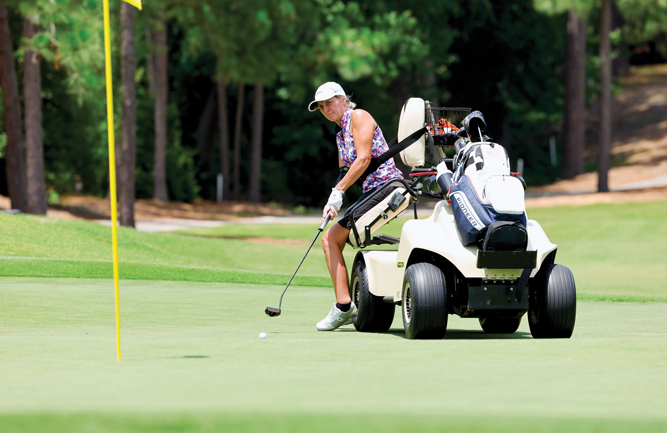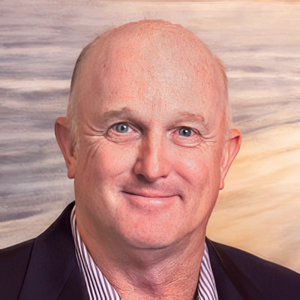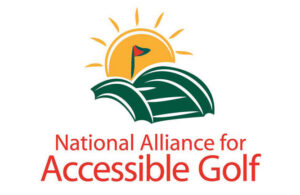How the NAAG is making the game more accessible
Golfdom sat down with Barton to get an inside look at what the NAAG offers golf course superintendents looking to make their courses as accessible as possible.
<p>The post How the NAAG is making the game more accessible first appeared on Golfdom.</p>
In 2022 when the USGA hosted its first U.S. Adaptive Open, it chose Pinehurst Resort as its location. Perhaps the most iconic golf resort in the country, Pinehurst has played home to 13 USGA championships — including this year’s U.S. Open — so playing the first Adaptive Open on Course No. 6 at Pinehurst made perfect sense.
Fast forward two years and after two successful tournaments at Pinehurst, the USGA is taking the U.S. Adaptive Open on the road.
Sand Creek Station, a 7,200-yard Jeff Brauer design in Newton, Kan., will host the 2024 tournament, a sign of how much the commitment to accessible golf has grown since that first event. Although it’s not associated with the Adaptive Open, the National Alliance for Accessible Golf (NAAG) is another organization dedicated to expanding not only golf’s player base, but those who can secure jobs on the course as well.

As part of the National Alliance for Accessible Golf’s self assessment, superintendents will need to evaluate if their greens are accessible for adaptive golf cars. (Photo courtesy of USGA)
At the helm of the organization is Dave Barton, executive director. Golfdom sat down with Barton to get an inside look at what it offers golf course superintendents looking to make their courses as accessible as possible.
Golfdom: Dave, thanks for taking the time to sit down with us today. What can you tell us about yourself and how you ended up leading the NAAG?

Dave Barton
Dave Barton: I’m a retired Navy pilot. I got into the golf business in 2005 because I’m a glutton for punishment (laughs). I managed properties with (Raspberry Golf Management) up in Northern Virginia and I had an ownership interest for about eight years.
Then, I moved down here about five years ago to work for the National Golf Course Owners Association where I ran their education department and Golf Business magazine. I was the editor of that, which is saying a lot because I had no magazine or editorial experience whatsoever. Thankfully they had some amazing people, so I just had to kind of say, “Hey, here’s what we want to talk about. Let’s make it happen.”
I started (at the NAAG) about two years ago, and we’ve had, not unlike a lot of 501(c)(3)s, a day-to-day battle sometimes for survival. But we’ve reinvested in ourselves over the last 18 to 24 months on a very, very small scale, relaunching our education platform as opposed to just having resources.
We’re really proud of GAIN (Golf Access and Inclusion Network) and the education hub. It’s really the secret sauce for us. PGAs and superintendents can get education credits, and it allows us to deliver this education to golf course facilities, staff and leadership so they can be knowledgeable. And, as we grow our numbers, it’ll help folks decide that we’re somebody to
associate with and then we can reopen our grant program.
Golfdom: NAAG has been around for more than 20 years. For our readers who have never heard of the organization, what can you tell us about what you offer?
Barton: (The NAAG) was formed out of some working groups in the mid-1990s when leading golf associations, and even some academia, realized that when the ADA (Americans with Disabilities Act) came out, it really only addressed buildings. It didn’t address the recreational aspect of a facility such as a golf course. It worked on the clubhouse, but not the golf course. If there’s a big building at a club, it applies to the building, but nobody talked about the course accessibility.
So, they had six working groups, and in 2001, the alliance was created. For most of our existence, we’ve worked to increase the participation of people with disabilities in the game of golf through education, whether it’s through programs or creating employee resources to help the golf industry.
And so that’s where we’ve got some grant money that we want to earmark … for golfers or maybe employees, getting someone into the golf business as an individual with a disability that wants to work in golf. Maybe it’s a scholarship or two for an up-and-coming high school senior who’s looking to go to college that’s interested in sports and golf. So, there are options there for us. That’s really what we do.
In the grand scheme of things, we target, in a positive way, the places where people can play golf or learn to play and to help them understand what they’ve got to do be compliant with the ADA.
We’re not the Department of Justice, we’re not an enforcing agency. And with our golf background and the folks on our board of directors, we have a lot of credibility when we start talking to golf course owners, operators or leaders. We’re not entry-level staff as far as how things work on the golf course.
 Golfdom: How can superintendents get involved with the NAAG?
Golfdom: How can superintendents get involved with the NAAG?
Barton: The superintendent has such a sphere of influence over the course and every integral part of the course, whether it’s paths, benches, barriers or curves … the superintendent kind of owns that space. So, I think they just have to work with the pros and understand and make sure the course is accessible.
Some of this stuff is not free, but we do think most golf courses are much better off than they think they are. But there are other things that we want to educate them about.
So again, we just aspire to make this education easy to find and uncomplicated to understand because the ADA is a big document and it’s just not that complicated.
That doesn’t mean it’s free if you’ve got some things you’ve got to do, but we can educate you on that. I think a lot of what we do is dispelling myths. We’re in the business saying, “Look, here’s what the deal is. Here are some solutions, here’s how you can do it ideally and cost-effectively.”
Golfdom: What’s a good starting point for superintendents looking to get involved?
Barton: It starts with a self-assessment.
So, if I were to talk to a superintendent who asked, “Hey, how do we do this?” I would say, before you go too far down the road with some of these things, have you done a self-assessment of your golf facility? There’s a checklist that does that. The ADA puts it out, and it’s easy to find all over our website.
It’s a seven-phase checklist and it’s got big pictures. It asks things like, does your course have curves? How far apart are they? How far spaced out do you have access routes? Access routes don’t have to be paved, but if they are, are they wide enough (for golf cars)? Can people get to and from the golf course? Can a golfer get on every green and at least one or a couple of the tee boxes depending on how many tee boxes you have?
That’s what the access part of the game is. We would refer them to that to start with because I’m a believer that if you’re going to have a course that’s going to have adaptive golf programming and even host an adaptive golf tournament, your course ought to meet those standards established by the ADA. I mean, it is a law, right? And that’s what we tell the operators, too.
Then, does your website indicate that you welcome golfers of all abilities, right? Is it accessible for someone who might have a vision problem or some other impairment where they have to do different things from the website to understand what you offer?
And then really the third question is how educated is your leadership? Because culture feeds from leadership. So, if your leader- ship understands what the requirements are, you can build that culture of inclusivity for the golfers, which in the end benefits the staff that’s working outside, the staff that’s working inside, and they’re having positive customer service experiences both ways.
That is the secret sauce. You don’t know what you don’t know. But if you can get pretty smart in about three hours, it’s not a bad thing to do. The self-assessment is just that. It’s not a certification, but it’s just showing you your facility has a level of commit- ment. I would encourage (superintendents) to speak with the operations side of the facility and work together and find out where they all stand on this and what needs to be done. What’s going on with all the inside stuff with disability etiquette and communications? Are we training on that? What are we doing as a property as a whole working towards the same objective?
Golfdom: How do you encourage superintendents or golf professionals — aside from being a feel-good thing and something that looks good on paper for the club — to invest their time and resources into this?
Barton: That’s a good question because folks might not necessarily see the demand. So why put all this effort into it?
To answer that, I would ask someone why they would not want someone to play golf at their facility? It’s a game for everyone. And the reality is that friends of mine I play with that are over 40 — way over 40 — they drag their feet on the greens around holes, and they do as much damage, more damage than these carts that the superintendents can be concerned about.
So, we’re educating about that.
But I think in the end, it’s just reminding them why they should do it. It’s because they are people, they’re no different than you and I. They have different abilities. And do you not want to welcome people to play golf at your golf course?
A chance encounter, a new partner
Kafka Granite partners with NAAG after making a new friend
Most golf fans are familiar with the inspiring story of Amy Bockerstette, a golfer with Down Syndrome who famously parred the 16th hole at the 2019 Waste Management Phoenix Open. Paired with Gary Woodland, who would go on to win the U.S. Open later that season, she told him, “I got this!” before hitting out of a greenside bunker to an adoring crowd. The video has been watched more than 55 million times.
Turns out, Bockerstette is still motivating people. Kafka and the NAAG’s partnership had unique beginnings at the 2024 GCSAA Conference and Trade Show in Phoenix.
“(Dave) had been running around looking for a putter for Amy Bockerstette to do a putt at the sustainability pavilion,” says Tiffany Koss. “He had met with one of my reps first and said nobody had a putter to use. He came off the PGA where every aisle you can go find a putter, but apparently, at the GCSAA, no one’s trying to sell that, but we happened to have one in our booth. He ran with our crappy old putter, and it did the job.”
Koss adds that Bockerstette stopped by the Kafka booth later in the day to thank the crew for their help. That’s when she and Barton got to talking about the NAAG and its mission.
“I felt a lot of synergy. This something that I want to be a part of and not just from his story and passion and messaging around making golf more inclusive, it comes from experiencing things firsthand. I have friends, family and employees who have disabilities and am inspired by what they’re able to do in their personal life,” Koss says.
Koss adds that Kafka’s wax polymer pathway product has a role to play in the continued push toward accessibility, making a partnership between the two organizations a perfect fit.
“In those instances where they need an option to make a pathway or walkway more accessible for an individual, it is an option that we can help provide,” she says. “I felt like there was a lot of good we can do there. I’m excited to help Dave with their mission.”
<p>The post How the NAAG is making the game more accessible first appeared on Golfdom.</p>
